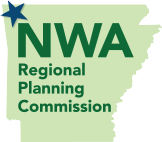Transit
Transportation Alternatives Studies
2024 Transit Alternatives Study
In 2024 NWARPC hired WSP consultants to develop a Transit Alternatives Study (TAS) and incorporate new transit modes in the ongoing Travel Demand Model update. The project will include an assessment of alternative transit improvements to better connect Bentonville, Rogers, Lowell, Springdale, Johnson, and Fayetteville with a rapid transit service. The TAS will examine the benefits and costs of fixed rail, bus rapid transit, and light rail to best meet the needs of residents and visitors of the growing NWARPC region. The study will be completed by the end of 2025 and will be incorporated in the forthcoming Forward2050 Metropolitan Transportation Plan.
The purpose of the TAS is to address the identified transportation challenges of rapid population, business, and land use growth through a multimodal analysis that leads to the development of a locally preferred alternative (LPA) for public transportation in the corridor. To meet this purpose, the project will focus analysis on transit concepts that:
- Provide direct and accessible connections between major activity centers
- Provide safe, affordable, and competitive schedules and reliable travel times for the commuting workforce
- Expand access to healthcare, education, and employment centers
- Strengthen transit linkages between high-density housing areas and large employers
- Support future housing and economic development plans
- Support achievable construction, operational, and fiscal responsibilities
You can get involved by sharing your opinions about the types of transit amenities and services that are important. Please comment and encourage others to do the same through by taking our Transit Alternatives Survey by June 30, 2025.
2014 Transportation Alternatives Analysis
In September 2014 NWARPC completed and adopted the Transportation Alternatives Analysis. Here are the documents delivered as part of the study:
- Northwest Arkansas Alternatives Analysis Final Report
- Northwest Arkansas Commuter Corridors Alternatives Analysis: Transit Oriented Development Scenarios
- Modeling Transit Ridership – Special Markets Technical Memorandum
- National Transit Data for Razorback Transit and Ozark Regional Transit 2007-2012
The objective of the Alternatives Analysis program (49 U.S.C. 5339) was to assist in financing the evaluation of all reasonable modal and multi-modal alternatives and general alignment options for identified transportation needs in a particular, broadly defined travel corridor. The transportation planning process of Alternatives Analysis includes the following:
- Completing an assessment of a wide range of public transportation or multi-modal alternatives, which will address transportation problems within a corridor or subarea.
- Providing information to enable the Secretary to make the findings of project justification and local financial commitment.
- Supporting the selection of a locally preferred alternative.
- Enabling the local Metropolitan Planning Organization to adopt the locally preferred alternative as part of the long-range transportation plan.
The Northwest Arkansas Regional Planning Commission was awarded a Federal Transportation Administration Grant to conduct a study for a potential fixed rail guideway system. The engineering, design and construction firm, URS Corp. (currently the AECOM company), was selected to conduct the study.
Summary of the NWA Alternatives Analysis Project:
In January 2012, the NWARPC began an Alternatives Analysis study to examine a variety of fixed-guideway transit systems between the cities of Greenland and Bella Vista. The focus of the study was to determine a “Locally Preferred Alternative” (LPA) which, at the time, was a Federal Transit Administration requirement if federal New Starts (Major Capital Investment) dollars are pursued. The study narrowed the alternatives to new location Light Rail, Commuter Rail within the Arkansas and Missouri Railroad right-of-way, and Bus Rapid Transit (BRT) on US 71 B.
On September 24, 2014 the NWA Regional Planning Commission voted to accept the Alternatives Analysis Study with the following motion:
“The RPC/Policy Committee moves that the Alternatives Analysis Study be accepted with the understanding that none of the alternatives considered are financially feasible at this time based on low ridership forecasts, high capital costs, and not meeting the FTA threshold to receive federal funding. The RPC/Policy Committee also recommended that the Policy Committee consider the path forward as recommended in the study which identified, among other measures, the existing commuter rail corridor on the Arkansas and Missouri Railroad as having the most potential for a future fixed guideway system”.
Study Results:
Purpose and Need: The Purpose & Need can be summarized as providing capacity for increased travel demand while fostering economic development and sustainable urban redevelopment that radiates from station areas.
Technical Feasibility of the Alternatives: Light rail vehicles cannot operate on freight rail lines. However, more modern, higher performing, and quieter commuter vehicles (DMUs or diesel multiple units) are a possible alternative adjacent to freight rail lines on new track (double track).
Ridership Findings:
The study utilized the NWARPC Travel Demand Model to forecast the following ridership levels for year 2035 as follows:
- New location Light Rail: 356 daily riders
- Commuter Rail: 1,368 daily riders
- Bus Rapid Transit: 378 daily riders
The final report points out that without a transit component in the NWARPC Travel Demand Model, the study was very limited and may have different results after transit modes are incorporated into the model. The Commuter Rail alternative showed the most potential in ridership as well as generating Transit Oriented Development (TODs) in downtown areas of Northwest Arkansas. For more information on the ridership modeling please see the Modeling Transit Ridership – Special Markets Technical Memorandum.
Estimated Capital Costs of the Alternatives:
- New location Light Rail: $2.286 Billion ; Commuter Rail: $664.0 Million ; Bus Rapid Transit: $97.8 Million
- Estimated Operations and Maintenance costs are detailed in Section 6 starting on page 79 of the Final Report .
Locally Preferred Option:
The Locally Preferred Alternative (LPA) is the Commuter Rail on the right of way of the A&M Railroad, along with a new location segment from Bentonville to Bella Vista. The report points out that: “The selection of an LPA does not mean that this project is to be pursued above all other transit options, or other surface transportation options. It simply means that, of the projects proposed for this regional corridor, it is the one for which Federal funding assistance would be requested if NEPA and other funding requirements were met. An LPA can also be revisited and modified if and when a NEPA process is initiated.”
Findings:
- The LPA, along with the other alternatives that were considered, is not currently eligible for New Starts (Major Capital Investment) Funding.
- Without Federal Funding or other funding source, a Fixed Guideway proposal is not eligible for inclusion in a financially constrained long range plan.
- Highway Widening will not achieve all the goals.
- There are advantages to a non-Federally funded project.
- A&M Ownership is experienced in Passenger Service.
Recommendations: The Study recommends a path forward stating:
Northwest Arkansas communities should work with NWARPC to improve its existing public transit service and to get “Transit Ready.” Whether Federal funding is sought or not, a successful fixed guideway project must be developed side by side with a sound bus service expansion plan and an economic redevelopment plan that begins at the station locations and radiates outward into the broader community. As presented at the end of Section 7, transit supportive development policies may go a long way toward making a project eligible for Federal funding for New Starts projects. Even if Federal funds are not received or not sought, the affected municipalities in NWA should work to enhance and develop a comprehensive set of zoning and public finance policies to promote walkable, sustainable neighborhoods in the A&M /Razorback Greenway corridor.
The report presents the following recommendations:
- The Northwest Arkansas Region should create and adopt an integrated land use and transportation plan that is based on promotion of mixed use development patterns.
- Communities in NWA could become “transit ready” ahead of a system being built.
- Keep the development focused in the urban corridor.
- Look for ways to add energy and developer interest in the communities and downtown areas between Fayetteville and Bentonville.
- In addition to the rail LPA along the A&M, begin a stage development of high quality Bus Rapid Transit (BRT) along US 71B.

